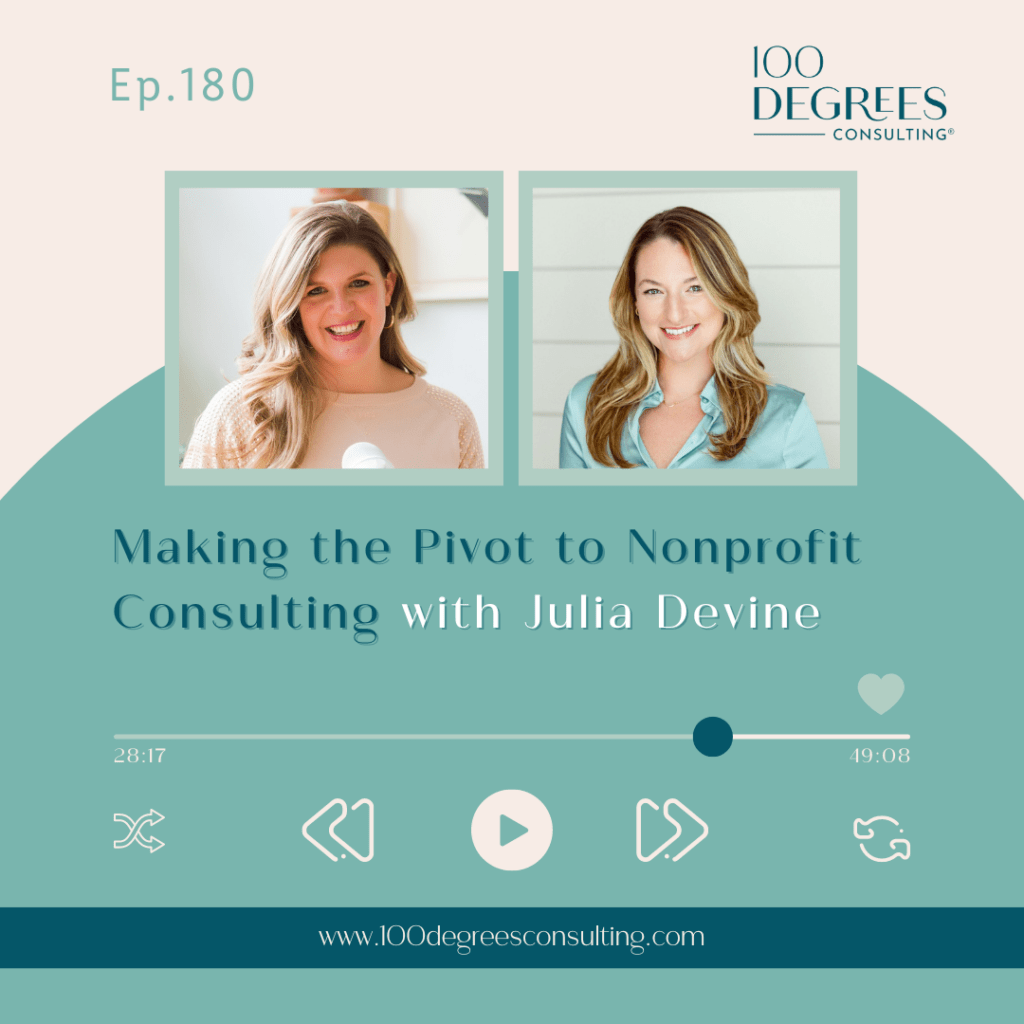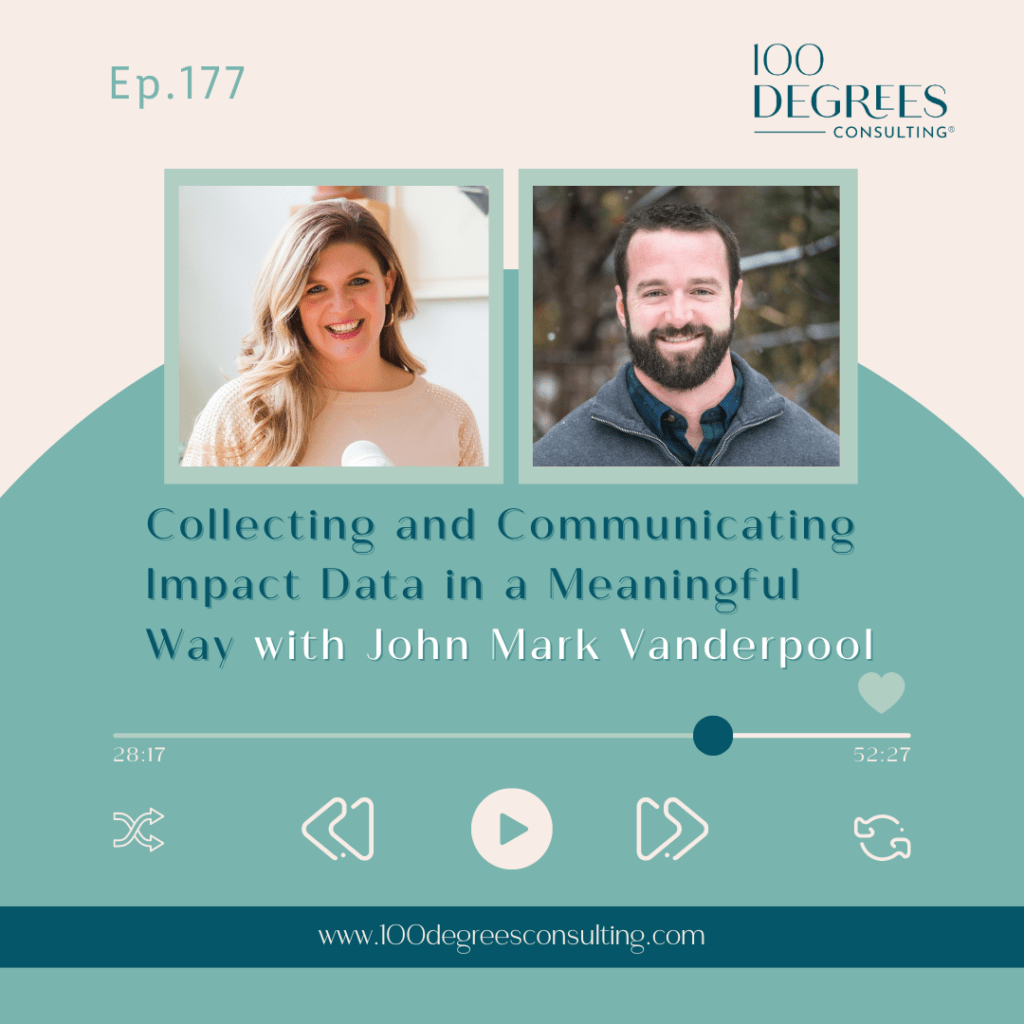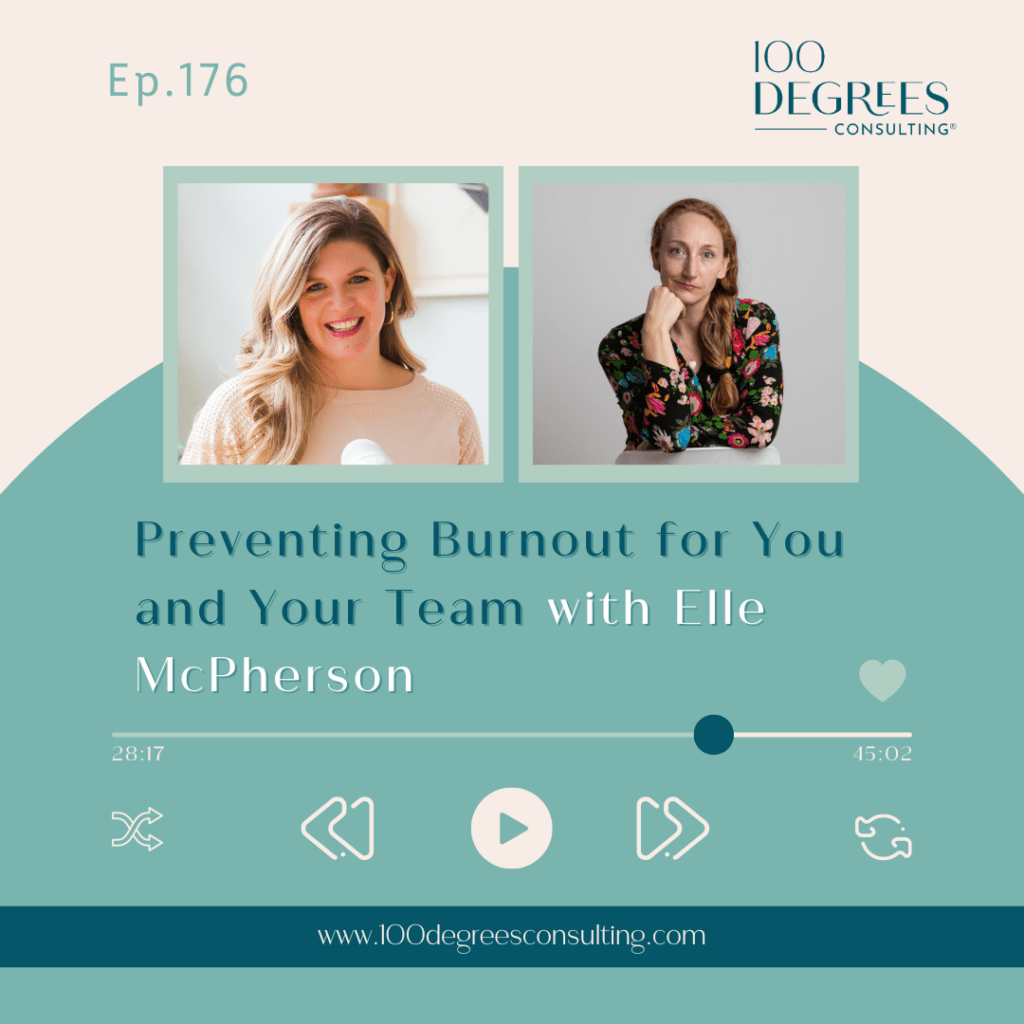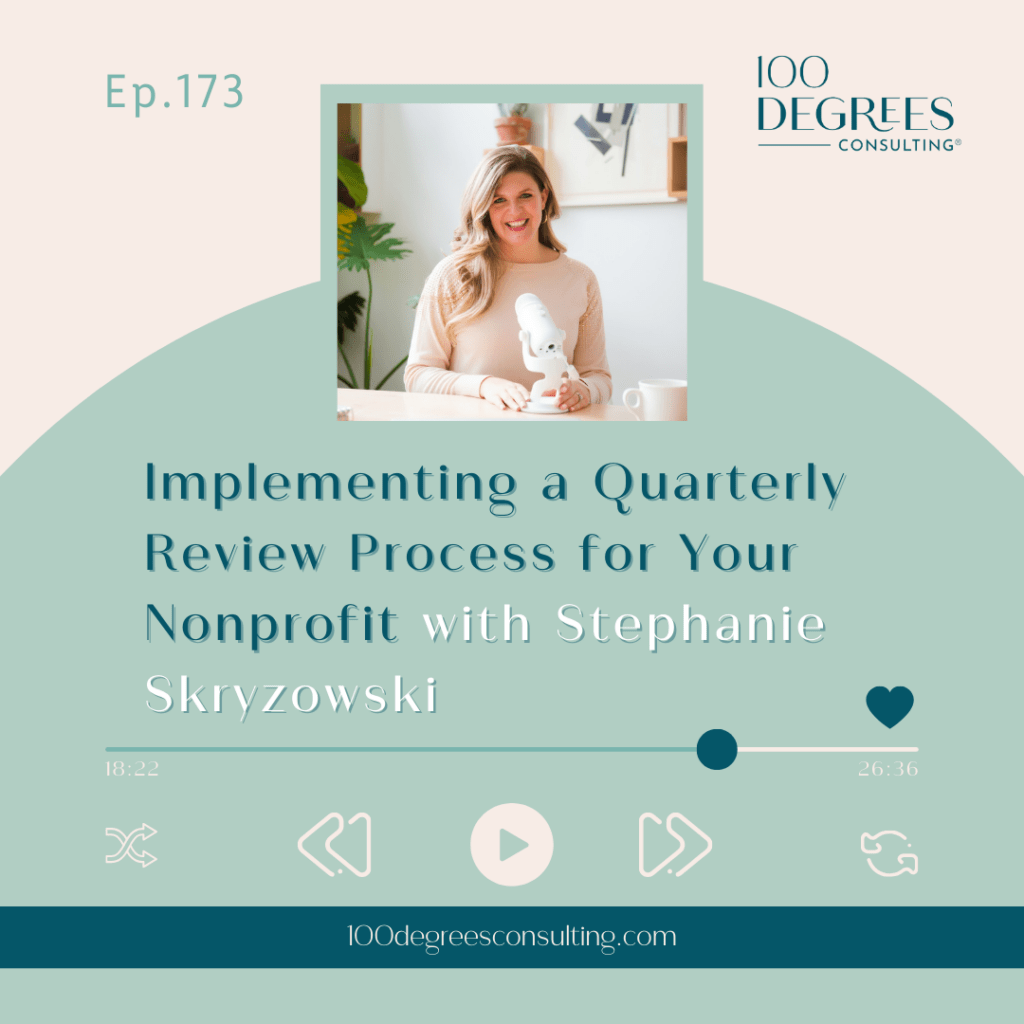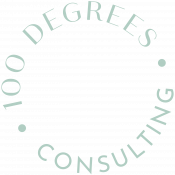Transcript Episode 165 – Behind the Scenes of Our 2024 Team Retreat on The Prosperous Nonprofit
[00:00:00] Stephanie Skryzowski: Welcome to the prosperous nonprofit, the podcast for leaders who are building financially sustainable and impactful nonprofits and changing the world. I’m Stephanie Skrzewski, a chief financial officer and founder and CEO of 100 degrees consulting. My personal mission is to empower leaders to better understand their numbers, to grow their impact and their income.On this show, we talk to people who are leading the nonprofit sector in new. Innovative, disruptive, and entrepreneurial ways, creating organizations that fuel their lives, their hearts, and their communities. Let’s dive in.
Hey, everybody. Welcome back to the Prosperous Nonprofit. I am excited to be here with you today, just days after our annual team retreat, because I want to share all about it with you. It was awesome. [00:01:00] And, um, a team retreat is something that we have done for several years now, because as you know, I have a remote team of 15 employees around the world and none of us live in the same, well, a couple of people actually live in the same city, but for the most part, we are spread out across the country and even a few people in the Philippines.
And so I like to. As much as possible and get everybody together every single year in person to just get to know each other on a more personal level that you just really cannot accomplish via zoom as much as we would like. And you know, do things where we can learn together, where we can have fun together.
And I think it’s a huge benefit to the organization. So It is not a small investment. I will tell you that for a fact. It is not a small investment to fly 10 or 15 people to a location together and pay for hotel rooms or Airbnb and all the food and the activities and all the things. It’s not a small investment, but it’s just that.
It is an [00:02:00] investment. into the organization. And I have always felt that way. And I, I really feel strongly that this is something that is really important for our team as we continue to grow. And so I have done this for several years. So this year we were in the Finger Lakes of upstate New York. So if you know, I am in Buffalo, New York.
And so the Finger Lakes are very close to me, about an hour and a half away. And we stayed at a hotel this time as compared to an Airbnb in prior years. It’s getting more and more difficult to find an Airbnb that will comfortably sleep all of us. We had 12 people this year who were with us in person.
And it’s just very important to me that everybody has their own space. And so we chose to go with a hotel this year. I think it was a fantastic choice. In years past, we’ve been in Scottsdale, Arizona, Nashville, Tennessee, Charleston, South Carolina, and all of those, we stayed at a big, big Airbnb. So this is kind of fun to have a different [00:03:00] experience at a hotel.
And I’ve also been to other retreats. Where we’ve had different, you know, different experiences where it’s been more of like a cabin camping bunk situation. I’ve been to other retreats where it is a shared Airbnb and I will say as an introvert and knowing my team that they are also largely introverts is a really important for all of us to have our own space and be able to really get away.
And in the Airbnbs that we’ve stayed at before, everyone has had their own room. We’ve not. Um, I think with one small exception, we’ve not made people share rooms, um, but still it’s like people are still in the living room or in the kitchen hanging out and you feel like, Oh, I should probably be there. And even though I really just want to be in my room right now.
And so the hotel was really a good option for us. Now, I will tell you, I was a little bit nervous about a hotel because I was like, well, what if people just disappear? Right? Like, what if people just, like, disappear? exit to their room and we never see them again. And that didn’t happen. I don’t know what I was thinking [00:04:00] really, but it was definitely a fear of mine and that didn’t happen.
We were at a relatively small hotel. It was not like a massive conference center or anything. And so, you know, we were together from eight or 9am really all the way through, you know, the end of dinner at eight or 9pm with some pretty significant breaks throughout the day. And so I didn’t get the sense that like, people just took off and, you know, didn’t want to be around us anymore, which was really good.
So anyway, so that was great. So I really loved the location. It’s difficult for people to get to because we have people that are coming from literally all, you know, all four corners of the country and some are coming from very small airports and, you know, Rochester, New York is also kind of a small airport.
So that was a little bit tricky, but I’m really not sure how we will ever get away from people having to. Take flights with a connection, you know? So that was something that we considered, but it was a little difficult to find a great solution [00:05:00] for it. So if you’re thinking about a retreat, maybe you have your entire team and you’re all local or most of you are local, that’s fantastic.
And that’s going to save you a lot of money because you’re not going to have airfare for, you know, a lot of people all coming into one place. But if you’re not, if you’re remote like us, you know, thinking about. airports and travel time and maybe even doing a little bit of a sample. Um, okay. If I need someone to get from Denver to Savannah, how much is that going to cost?
What is that going to look like? How many flights are they going to have to take to get there? Right? So just kind of doing a couple samples of people where they’re coming from and where you’re going to will help. Um, we did that when eliminating a handful of solutions because we’re like, yeah, we can’t have.
the majority of the team needing to take three flights to get to this place. Um, and so that was, uh, definitely a huge factor for us. The other thing that we have kind of experimented with over the years is the length of our [00:06:00] time together. And I think one thing that we learned and that we found is that we actually wanted more time this year.
So we did only three nights. So everyone arrived on a Monday. You know, Monday afternoon and departed on Thursday morning. In the past, we’ve done arrive on Monday, depart on Friday, and I think we would go back to that again. So we’re just trying new things every year and learning from what works and what doesn’t work and, you know, revising for the next year.
So this year we only did three nights. And what that meant was that our schedule was a little bit more, um, tight than we would have liked. You know, we are all inclined, I think, on our team to just like pack our itinerary full. And what I did learn from past retreats was that people need more spaciousness.
Heh. in the schedule. Like we cannot go from a learning session to an activity to a meal to another learning session without some pretty significant breaks in there. And so the breaks were like a non negotiable this year in our [00:07:00] schedule, but that meant that we kind of had to do double duty with a couple of things.
So the first night, um, everyone arrived, you know, around check in time at the hotel, maybe 3, 4 PM. And then we had dinner. A private dinner, which was lovely around 7 PM. But in order to sort of do a state of the business address, like I like to do, it really go deep into show people like, what did 2023 look like?
What were our numbers for last year? What were our challenges? What were our wins? And just get people like an idea from my perspective as CEO, what’s going on in the company right now. Transcribed Um, we had to do that during dinner. And so we ate dinner, we enjoyed, and then, um, you know, before we wrapped up, I had everybody still sitting at the table, enjoying a drink or enjoying a little dessert and going over the state of the business.
And I think it would have been, you know, people are tired from a day of travel and I think it probably would have been nicer if we could just leave that first night to a really fun, just [00:08:00] social bonding time together and then kick off the agenda the next morning. So when thinking about the length of the review.
treat going back to coming Monday, um, leaving Friday. I think that would have given us a little bit more time. The other thing that we did not have time for this year was doing a service project. So last year when we were in Scottsdale in the Phoenix area, we were able to do a service project with one of our clients and helping in their food bank.
And that was. Awesome. I think largely the team really liked that activity and just being able to see one of our clients, you know, in person, which is really cool because we’re always remote, you know, we’re always on zoom. And so it’s just for us, especially as finance people, you know, we are looking at their financial reports.
And now we can see, Oh, this client that spent this much money on the food bank that I see in their, you know, profit and loss statement. Wow. I can see this like in real life. I’ve actually seen the food bank. So it was a really cool connection to [00:09:00] have. Um, and that we just did not have time to do this year.
And so again, extending the time can include that really important activity. So, um, I think, you Um, definitely four nights would have been much better, um, suited to us. And I, I think, I think the team would agree. And so when you’re thinking about length of time for your retreat, really making sure that you’re including spaciousness very intentionally in the schedule because you don’t want every minute spoken for.
I had really encouraged our team in previous years, like, I don’t want you working this week. But what I thought I was doing was giving them permission to just like, you know, be okay with not, you don’t have to be on 24 seven. You don’t have to be working around the clock when you’re here. But that actually put a lot more pressure on the team that like, Oh, I’m not supposed to be working, but I really just need to answer this question.
client’s email or I’m not supposed to be working, but I actually really need to run payroll for this client this week. And so [00:10:00] it almost put like too much pressure, the other direction on them. And so what we did this year was we, um, had a couple blocks of time every day of like a couple hours where, you know, between the end of our sessions and when we needed to be together for dinner again.
And people could use those blocks. blocks of time, however they wanted. If they wanted to go take a nap, great. If they wanted to go swimming, yes, this place had a heated pool, even though it was literally snowing outside, um, they could go swimming. If they wanted to go answer emails to just feel like they were on top of things, they could do that too.
And so it felt like a little bit less pressure to like, Oh my gosh, I’m not allowed to check my email versus, you know, just being able to do what they felt that they needed for them. So I think that was, I think that was good. And then, um, what we tried to do with our. training sessions, um, is, and we actually pivoted a little bit like midweek because, um, what we tried to do was really [00:11:00] sort of continue the same themes throughout the week.
So we weren’t jumping from training topic to training topic to training topic. And so we were introduced, um, and we had one of our amazing CFOs lead us in a session around design thinking and. Basically using that time to think through some of the challenges that we run into as a company and use this design thinking process to brainstorm ideas on how to address those challenges.
Yeah, so that was really interesting and we were able to, you know, kind of continue that theme and that session throughout, um, our time together rather than doing a little bit of design thinking and then totally switching gears to something else. And I think we actually initially had one other topic on the agenda that we decided to postpone for a virtual team meeting in the future because it was a brand new topic that we would be introduced that we hadn’t yet talked about.
And, [00:12:00] you know, we wanted to just sort of finish out and close out nicely this design thinking session that we had started before. And so, um, I think there’s a couple of lessons here is really making sure that you have a consistent theme and that you’re continuing to talk about the same topics. Now you don’t need to like, you know, drive home this point and like to the point where it’s not useful anymore.
All right. And at the same time, like we don’t want to continue introducing like new ideas because the team is going to not really be able to take away a whole lot, right? So I think that was big. And then the ability to pivot, I was just getting the sense that we were cramming, trying to cram a little bit too much in there.
And so I asked the team, um, who was responsible, like, Hey, can we. Can we shift this? Can we pause this one session and just continue what we were working on before? And everyone is really flexible to do that. And so I think that, you know, it didn’t really, it didn’t really jack up our plans too much, but it was really helpful to be able to just, um, kind of move things around a little bit.
So I [00:13:00] think that was great.
Hey there, amazing listeners. I hope you’re enjoying another fantastic episode of the Prosperous Nonprofit. Before we dive back in, I have a quick favor to ask. That’s right. If you are getting value, knowledge, encouragement, or even just good vibes from our show, please share the Prosperous Nonprofit with a friend or colleague who you think would love it as much as you do.
It’s like passing along a good book or recommending your favorite local coffee spot. Please take a quick second to hit that share button, send a link, or even give a shout out on social media. Your support means the world to me. Thank you for being awesome. Thank you for being here. And now back to the show.
We tried to have a mix of training sessions where we’re introducing new ideas or concepts to the team and they’re learning something. As well as 100 degrees sessions where [00:14:00] we were really informing the team and gathering feedback around the company, right? How is the company doing? Where are we going?
What is the vision? Um, and, and that, and I think that was a nice balance that last year, I think the balance was too far on the training session side and less on like the, how is the company doing? What is our vision? We kind of flew through that last. year and that felt like a really a missing piece. This is why we do a debrief of every single retreat so we can learn from it and make, um, you know, new improvements for the following year.
So if you’re thinking about doing a team retreat, I would really think about that balance. People are just inherently curious about like, how is our organization doing? Think about the things maybe that you talk about with the board and how could you share that information with the team. So that they feel really informed and sort of bought into how the organization [00:15:00] is doing as a whole and maybe not just all like education type sessions.
So I really, really liked the mix that we struck this year and I think it resonated well with the team. And again, if we’d had that extra day, I feel like we could have gone a little bit deeper into a couple other areas. And I think that would have been beneficial as well. So in addition to the training stuff and the more, you know, educational things, we also always like to add in some activities, right?
It’s got to be a little bit fun too. If we’ve got people coming from across the country, around the country, we want to be able to, you know, have some fun together. So, um, a few things that we did this year were the second night we did a Mexican cooking class and mezcal tasting, which was so fun. I would call it maybe less of a cooking class and more of like a sort of immersive culinary experience, right?
When I think cooking class, I think of each person being sort of self taught. Stationed [00:16:00] and you know, you have your ingredients and everybody’s chopping at the same time. It wasn’t really that, it was just sort of like an interactive kitchen where everybody was watching the chef and if you wanted to participate you could, but it’s not like everybody was, the mescal tasting was super fun.
And this, um, kind of. doubled as our dinner and an activity. And that was, that was really fun. Um, one morning we had yoga. We made that optional. So if you do not want to participate in yoga, you certainly didn’t have to. We did yoga at another team retreat and we did it kind of at the middle of the day.
And so it, I think people felt like they had to, I think we did say that it was optional, but I think people felt a little bit like they had to. And, um, and I think maybe some people didn’t really enjoy that as much. And so we did this in the beginning of the day, this time. Um, and I think that gave people permission to opt out if they wanted to, if they wanted to opt out.
And so I personally love it. I love starting my day with some sort of movement. And so yoga is really fun. And then our [00:17:00] last night we did an art class. We did it. We had an art teacher come right into the property. And, um, she did, um, it’s called alcohol ink. It’s like this sort of very runny, um, paint ink type stuff that you dropped onto this, um, ceramic tile.
And the ink kind of swirled around and just made these really beautiful designs. And so we sat there together for about a week. Maybe like two hours, almost two hours, um, creating these, these beautiful works of art. And it was just really fun to see people’s creative side come out. It was after dinner. So we were all just, you know, laughing and having fun together.
And honestly, I was a little hesitant on that activity at first. I was like, Oh, aren’t people going to be tired? But my team, um, Um, really encouraged me like, no, we should do this. I think that’s going to be good. And I think people really did enjoy it. And I, I loved it. It was so fun. And the last thing we did, it wasn’t the last, it was the last thing I’m going to tell you all about.
Um, but it was not the last in our agenda, but our, our last day we did a photo [00:18:00] shoot. So we needed some new, uh, we needed some new photos of our team for our website. We needed some headshots of our new employees. And so we did a photo shoot and. I was really worried about this because not everybody loves a photo shoot as much as I do.
I don’t know if y’all know this, but I’m a big fan of a photo shoot. Um, and I only do them, you know, once a year or less. And so it was just so much fun. Um, and our photographer, uh, Natalie of NSP photography is somebody that I have worked with for, um, other branding shoots, for family photos. I’ve worked with her a handful of times and I.
Just love her. She’s based in Rochester, New York, if anybody wants to look her up, um, but Natalie’s fantastic and she made our team feel very, very comfortable. I think there were some people that were not super excited or comfortable about the photo shoot and, um, and she just made everybody feel really good and, and amazing.
So. That’s kind of the gist of what [00:19:00] our retreat looks like this year. And like I said, I kind of shared along the way as I’ve been talking to you what our learnings were and what we might do differently next time. Um, and so as always, we’re going to send a survey to our employees. Um, in the next few days or so and just kind of get an idea, like, what did they love?
What was maybe not their favorite? What’s most important to them when thinking about a team retreat? And use all of that information to plan for next year. So again, if you’re thinking about having a team retreat, the answer is yes. Yes. Yes. Yes. Do it. Um, if you, you know, if you can put it in the budget and if you’re in the process right now of building your budget and you have a decently sized team who spread out, um, especially if they’re spread out and you don’t see each other all the time, I cannot emphasize enough what a great investment this is.
And it is an investment. So you need to budget for it. You need to prepare for it. Um, but it’s a fantastic investment into your organization. And [00:20:00] people just really feel. Like a lot, a lot more buy in, um, once they can be with you and be with the other team members in person, um, there’s just a much deeper connection forms that I think is incredibly valuable and you can’t really put a price tag on that.
So definitely an investment, but, but really worth it. And then it may be before, if you’ve never hosted a team retreat before, maybe, um, you know, sending a pre, not maybe, we always send a pre retreat survey, but you could even do like a pre pre retreat survey. Our pre retreat survey is asking about dietary restrictions, any special accommodations needed, um, is asking about what they would most like to learn and things like that.
I mean, I suppose you could, yeah, you could send that. And one thing we’re going to add to our post retreat survey is having our team rank what is most important to when it comes to the next retreat, right? Um, for example, is it most important to them to have, you know, beautiful surroundings? Or is it more [00:21:00] important to them to have an easier travel day?
Right? Um, or is it more important to them to have nice weather where we go? Right? Because we’ve, that has always been my priority is like, it has to be nice. It has to be nicer than where I’m coming from. And this year, of course, it snowed, um, the whole time, which we knew was a, a, a, a good A possibility here in upstate New York, but having them rank, um, what is most and least important to them, I think, uh, it’s going to be really helpful for us for planning next year.
The other thing I will say before I start to wrap up is that you’re not going to please everybody. And that’s been really hard for me because I and my team put so much energy and effort into making these retreats amazing for our team. It’s just not going to be perfect for everybody. There’s going to be something that somebody doesn’t like or somebody is going to have, you know, a bad flight experience that then sort of trickles into the rest of your time together.
It’s just not going to be perfect. But, um, the best you can [00:22:00] do is You know, take feedback, incorporate feedback where you can and, um, and really just think about the big picture. Why are we here? Why are we coming together? And what is, what’s most important? And so, um, I think that has served us well. And again, has our, have all of our retreats been perfect?
Absolutely not. Are there things that I would change about all of them? Of course there’s even, even though I feel like this was the best one yet, there’s still things that I would change about it and improve for next year. So I hope this was helpful in just giving you some ideas of what to think about when you’re planning a retreat.
Just knowing that, you know, it’s going to be an investment. And if you’re already thinking like, Oh, we don’t have the money in the budget for it this year. Okay, great. We’ll start thinking through, um, how could we incorporate this into our budget for next year? I think that is, um, it’s something great to be thinking about already.
So I hope this was useful, my friends. If you do follow me on Instagram, you may have caught a couple of weeks ago, I [00:23:00] posted a whole bunch of photos from our retreat after the fact. So if you checked it out, that’s fantastic. I’m over at stephanie. skry if you want to find me there. Okay, friends. Well, it was great to chat with you and share a little bit more about our team retreat.
And I hope it was so helpful and gave you some ideas about what to incorporate and how to, how to create that really nice balance. in your own team retreat. All right. I will talk to you next time, friends. Have a great day. Before you go, I just want to thank you for being here. To access our show notes and bonus content, visit 100DegreesPodcast.
com. That’s 100DegreesPodcast. com. And I’ll see you next time.


